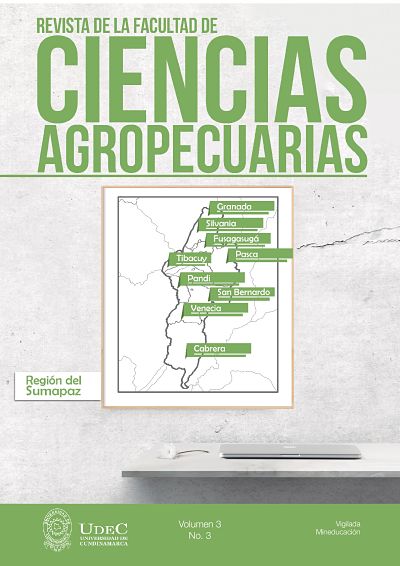Compaction, one of the most common causes of soil degradation
DOI:
https://doi.org/10.36436/24223484.225Keywords:
Compactación, suelo, macroporosidad, filtración, mecanización, ganadería.Abstract
This article presents a literature review related to soil degradation caused by different agricultural practices in Colombia, specifically soil compaction, one of the most common consequences. Colombia is a country with an agricultural vocation, this represented by the 50.91 million hectares dedicated to this purpose, however, 50% of the area destined for agricultural production itself is suitable for the implementation of mechanization, which is presented as a potential risk of increased levels of soil compaction, since due to the high weight of the machinery implemented imprudently during the different phases of cultivation, exerting high levels of surface pressure on the soil, its physical characteristics are altered, generating an increase in density, decreased structural stability, decreased filtration capacity, in addition to decreasing macroporosity, all this reduces the amount of nutrients that are able to reach the plant, noticeably affecting the functionality of the soil, together, about 45 million hectares of the country are destined for livestock activities, where often due to lack of knowledge and reduced accessibility to technological packages, extensionist production models are implemented, where overgrazing and overtrampling of animals, in Farms with excessively high animal loads generate soil degradation due to compaction.Downloads
References
Restrepo J. (2010) Una política integral de tierras para Colombia. Ministerio de Agricultura y Desarrollo Rural. Bogotá D.C., Colombia.
Rojas-Palomino A. (2007) Efecto de la humedad del suelo sobre el potencial productivo y la compactación en sistemas de producción Ganadero en zonas de ladera en la Tulia, Bolívar, (Valle del Cauca). Tesis de Maestría en Ciencias Agrarias, Área de énfasis Suelos. Universidad Nacional de Colombia, sede Palmira. Facultad de Ciencias Agropecuarias. Escuela de posgrados. Colombia.
Gómez Rodríguez Katherine. Alakukku, L. (1999). Incidencia de la compactación ocasionada por el tractor en las propiedades físicas en un andisol. Tesis de Maestría en Ingeniería -Ingeniería Agrícola. Facultad de Ingeniería. Departamento de Ingeniería Civil y Agrícola. Bogotá D.C. Colombia.
González O, Iglesia C, Herrera M, López E, Sánchez A. (2008). Efecto de la humedad y la presión sobre el suelo en la porosidad total de un Rhodic Ferralsol., Cuba: Revista Ciencias Técnicas Agropecuarias, 17:2;50-54.
Pinzón A, Amézquita E. (1991). Compactación de suelos por el pisoteo de animales en pastoreo en el Piedemonte amazónico de Colombia. Pasturas Tropicales, 13:(2);21-26.
Richmond P. & Rillo S. (2006), Evaluación del efecto de la compactación por el rodado de máquinas sobre algunas propiedades físicas del suelo y el cultivo de trigo en siembra directa, Argentina: INPOFOS Informaciones agronómicas No 32.
Montanarella Luca, Pennock Dan y McKenzie Neil. (2016). Estado Mundial del Recurso Suelo, Resumen Técnico. Organización de las Naciones Unidas para la Alimentación y Agricultura. Roma,
Horn, R. and Lebert, M. (1994). Soil compactability and compressibility. In: Soane, B. D. and van Ouwerkerk, C. (eds.). Soil compaction in crop production. Elsevier Science B.V, The Netherlands. p. 45-70.
Soane, B. and van Ouwerkerk, C. (1995). Implications of soil compaction in crop production for the quality of the environment. In: Soil Tillage Research 35: 5-22.
Commision of the European Communities (2006). Proposal for a Directive of the European Parliament and of the Council establishing a framework for the protection of soil and amending Directive 2004/35/EC.COM 232 final http://ec.europa.eu/environ-ment/soil/pdf/com_2006_0232_en.pdf.
Oldeman, L.R., Hakkeling, R.T.A. and Sombroek, W.G. (1991). World map of the status of human-induced soil degradation. An explanatory note. ISRIC, Wageningen,the Netherlands/UNEP, Nairobi, Kenya. 34 p.
Kirkham, D. and Horton, R. (1990). Managing soil-water and chemical transport with surface flow barriers. II. Theoretical. In: Agronomy Abstract 82: 213.
Eriksson, J. (1982). Markpackning och rotmiljo. Summary: Soil compaction and plant roots. Swedish University of Agricultural Sciences. Reports Divison of Agricultural Hydrotechnics 126: 1-138.
Ehlers, W. (1982). Die Bedeutung des Bodengefüges für das Pflanzenwachstum bei moderner Landbewirtschaftung. In: Mitteilungen Deutsche Bodenkundliche Gesellschaft 34: 115-128.
Koolen, A.J. and Kuipers, H. (1983). Agricultural soil mechanics. Adv. Series Agric. Sci. 13. Springer-Verlag, Berlin Heidelberg, Germany. 241 p.
Pietola, L., Horn, R. and Yli-Halla, M. (2005). Effects of trampling by cattle on the hydraulic and mechanical properties of soil. In: Soil Tillage Research. 82: 99-108.
Alakukku, L., Weisskopf, P., Chamen, W.C.T., Tijink, F.G.J., Van Der Linden, J.P., Pires, S., Sommer, C. and Spoor, G. (2003). Prevention strategies for field trafficinduced subsoil compaction: a review, Part 1. Machine/soil interactions. In: Soil & Tillage Research 73: pp. 145-160.
Simojoki, A., Jaakkola, A. and Alakukku, L. (1991). Effect of compaction on soil air in a pot experiment and in the field. In: Soil Tillage Research 19: 175-186.
Ball, B.C., Scott, A. and Parker, J.P. (1999). Field N2O, CO2 and CH4 fluxes in relation to tillage compaction and soil quality in Scotland. In: Soil Tillage Research. 53: 29-39.
Fullen, M.A., (1985). Compaction, hydrological processes and erosion on loamy sands in east
Shropshire, England. In: Soil Tillage Research. 6: 17-29.
Soane, B.D., Dickson, J.W. and Campbell, D.J. (1982). Compaction by agricultural vehicles: A review.
III. Incidence and control of compaction in crop production. In: Soil Tillage Research 2: 2-36.
Lipiec, J. and Stępniewski, W. (1995). Effects of soil compaction and tillage systems on uptake and losses of nutrients. In: Soil Tillage Research 35: 37-52.
Alakukku, L. (1999). Subsoil compaction due to wheel traffic. In: Agricultural and Food Science in Finland. 8:333-351.
Moore, G. (ed.) (2004). Soil guide: a handbook for understanding and managing agricultural soils. Dept of Agriculture, Western Australia. Bulletin No. 4343.
Chamen, T., Alakukku, L., Pires, S., Sommer, C., Spoor, G., Tijink, F. and Weisskopf, P. (2003). Prevention strategies for field traffic-induced subsoil compaction:a review, Part 2. Equipment and field practices. In: Soil Tillage Research 73: 161-174.
Schjonning, P. and Rasmussen, K. (1994). Danish experiments on sub- soil compaction by vehicles with high axle load. In: Soil Tillage Research 29: 215-227.
Arvidsson, J. and Hakansson, I. (1996). Do effects of soil compaction persist after ploughing? Results from 21 long-term field experiments in Sweden. In: Soil Tillage Research 39: 175-197
Hanssen, S. (1996). Effects of treatment and soil compaction on plant production of a dairy farm system converting to organic farming practice. In:Agriculture, Ecosystem and Environment 56: 173-186.
Radford, B.J., Yule, D.F., McGarry, D. and Playford, C. (2001). Crop responses to applied soil compaction and to compaction repair treatments. In: Soil Tillage Research 61: 157-166
Arvidsson, J. (1999). Nutrient uptake and growth of barley as affected by soil compaction. In: Plant and Soil 2008: pp. 9-19.
Alakukku, L. (2000). Response of annual crops to subsoil compaction in a field experiment on clay soil lasting 17 years.
Lipiec, J. and Stępniewski, W. (1995). Effects of soil compaction and tillage systems on uptake and losses of nutrients. In: Soil Tillage Research 35: 37-52.
Hakansson, I. and Petelkau, H. (1994). Benefits of limited axle load. In: Soane, B.D. and Van Ouwerkerk, C. (eds.) Soil Compaction in Crop Production. Developments in Agricultural Engineering 11. Elsevier, Amsterdam, The Netherlands, pp. 479-499.
Blake, G.R., Nelson, W.W., Allmaras, R.R., (1976). Persistence of sub-soil compaction in a Mollisol. In: Soil Science Society American Journal 40: 943-948.
Etana, A., Hakansson, I., (1994). Swedish experiments on the persistence of subsoil compaction caused by vehicles with high axle load. In: Soil Tillage Research 29: 167-172.
Wu, L., Allmaras, R.R., Gimenez, D. and Huggins, D.M. (1997). Shrinkage and water retention characteristic in a fine-textured mollisol compactions under different axle loads. In: Soil Tillage Research 44: 179-194.
Hakansson, I. (2005). Machinery-induced compaction of arable soils. Incidence-consequences-countermeasures. SLU Department of Soil Sciences. Reports from the Divison of Soil Management. 109;153.
Kooistra, M.J. and Boersma, O.H. (1994). Subsoil compaction in Dutch marine sandy loams: loosening practices and effects. In: Soil Tillage Research 29: 237-237.
Olesen, J.E. and Munkholm, L.J. (2007). Subsoil loosening in a crop rotation for organic farming eliminated plough pan with mixed effects on crop yield. In: Soil Tillage Research 94: 376-385.
Downloads
Published
How to Cite
Issue
Section
License
Copyright (c) 2020 Ciencias agropecuarias

This work is licensed under a Creative Commons Attribution-NonCommercial-NoDerivatives 4.0 International License.







